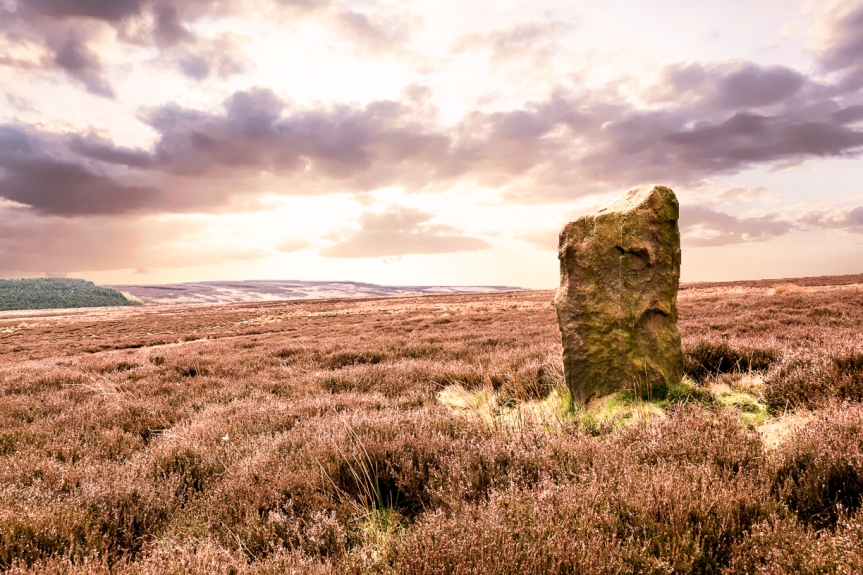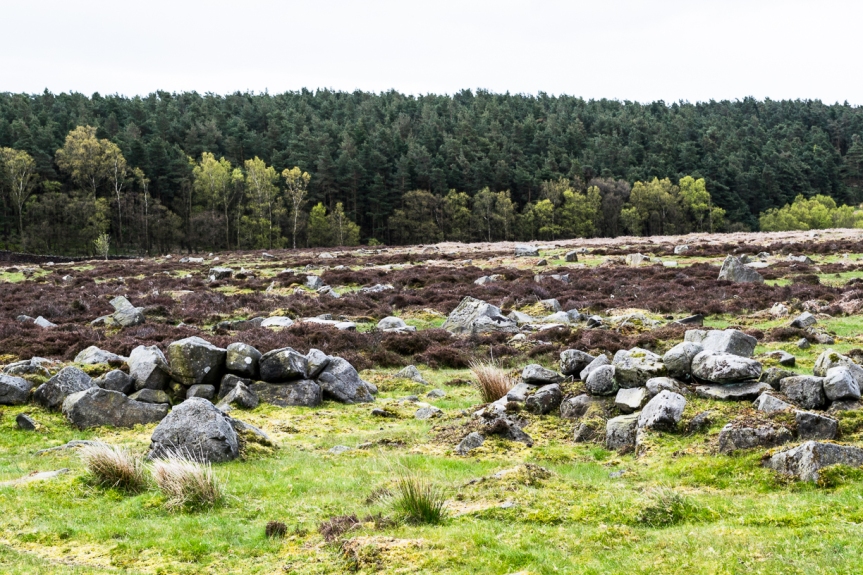
Getting there
SE 15196 54722 (OS Explorer 297)
Fairly easy to get to – if you don’t mind getting wet feet. Just be warned, there are several hidden dips in the long heather, some 2 or 3 ft. deep.
From Skipton in North Yorkshire – take the A59 towards Harrogate, and about 5 miles or so after the Bolton Abbey roundabout, you will come to the little church of Blubberhouses on the right – the signpost will point to Otley. From Blubberhouses church, walk up the slope (south) as if you’re going to Otley, for 100 yards or so, taking the track and footpath past the Manor House and onto the moor. Once you hit the moorland proper, take the footpath that bears left going down into heather and keep going till you hit the dead straight Roman Road path running west onto Blubberhouses Moor. Carry along the Roman Road for about 200 yards, and looking right (if you squint) you can just make out a small pimple half way up the moor ridge about a quarter of a mile away. That is where you are heading.
This is a lovely little prehistoric standing stone, first discovered by my walking buddy James Turner and myself 2 years ago.

I say ‘first discovered’ – we think it is a new discovery, and can find no reference to it anywhere. It doesn’t appear in Cowlings ‘In Rombalds Way’ (1946), or in either of William Grainge’s (1871; 1895) detailed history works of the region. We consulted with various people and no one is able to find anything about it. So we claimed it as our own and named it in our honor (if anyone knows of this stone we will gladly give them full credit)…

As it is a new find, we are unable to discover anything associated with it in the way of legends (many standing stones have some sort of tales attached to them – usually involving the Devil in some guise). But this one is silent.

It is a lovely little chap too – standing about 4 and a half feet tall, and it appears friendly enough (not all do – believe me). It may have had something to do with the nearby unexcavated Green Plain settlement – although closer to it is (or was) another smaller settlement which we first encountered when we discovered the stone.

Since then Paul Bennett and myself have paid another visit to the stone and noticed, sadly, that the little settlement has been destroyed and all that exists are now a pile of stones and a muddy field.

I don’t think this was done on purpose – probably land clearing by the local farmer. But it is still a shame.

This is a nice place to visit – regardless of whether you go to the James stone or not. The moors are stunningley beautiful, with lots of variety and several prehistoric carvings. It is a perfect place for a hike – with no one about. Great for an explore and blowing the cobwebs away!

There is so much waiting to be explored on these moors, who knows – you may find something new yourselves!

It seems that one by one, these ancient sites are being dismantled knowingly or not. Not good!
LikeLiked by 1 person
There is a severe law against damaging scheduled ancient monuments. I doubt it was done knowingly – but a shame nonetheless…
LikeLiked by 2 people
This is a lovely post. Your photography is gorgeous as usual. Makes my day.
LikeLiked by 1 person
Awww..thank you very much 🙂 🙂 🙂
LikeLiked by 1 person
Gorgeous heather photo at the end
LikeLiked by 1 person
Thank you…it is at its best end of august..shame it doesn’t last long
LikeLiked by 1 person
Wonderful images … you find so many interesting places. 🙂 Where myths and legends were are born ..
LikeLiked by 1 person
Thank you Julie…so much to explore and write about..I hope I have the time to do it 😊
LikeLiked by 2 people
I’ll miss your old blog, but the new one is gorgeous as well…. embracing change!
LikeLiked by 1 person
Thank you – I felt it was time to change…hope it works as planned ::)
LikeLiked by 1 person